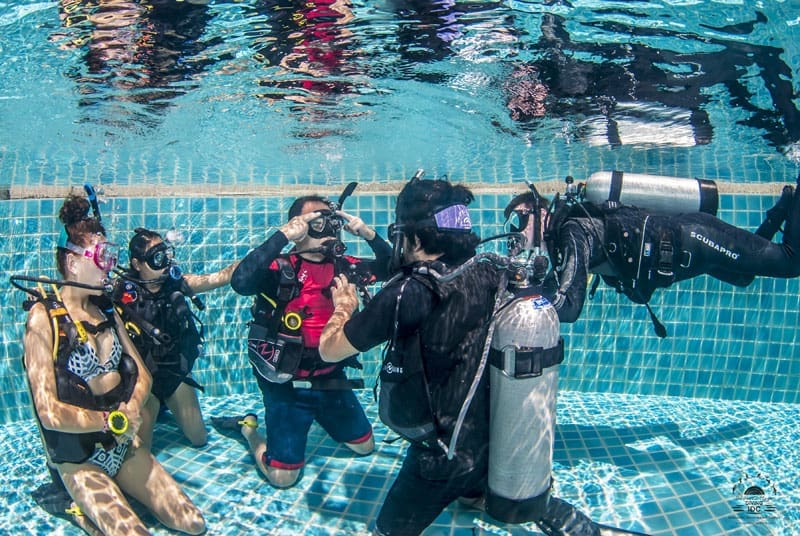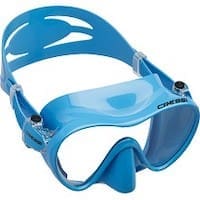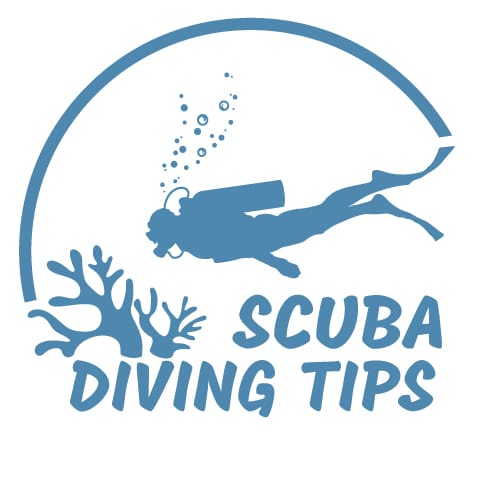How to clear a mask when scuba diving is for many new scuba divers the hardest diving skill to complete in their diving course. However, in many cases people overthink it and with some practice and a good diving instructor this skill is not so hard to master.
First of all I recommend you to not overthink the how to clear a scuba mask skill. In the end you breath into your mouth and out of your nose to clear it. But as soon as you start to overthink it, you start to worry. This leads to loss of confidence and when we loose confidence we have a tendency to shake, not think clearly and sometimes do the opposite of what we want to do. In this case we see new diving students breath into their nose instead of their mouth. If this happens you get water in your throat and that leads to panic.

So we learn that confidence is key in completing the mask clearing skill while scuba diving. In the PADI Open Water Diver Course you will be practicing how to clear your scuba mask many times to ensure mastery before getting your diving certification.
In the PADI Open Water course you will practice the mask skills first in confined shallow water. This makes it easy for you to stand up if somethings go wrong and it makes people relax knowing they can stand up if needed. In confined water you will practice in order: Partially Flooded Mask, Fully Flooded Mask, Mask Removal and Replacement, Mask Removal and Replacement breathing for 1 minute and No Mask Swim. Then on the open water dives you will repeat: Partially Flooded Mask, Fully Flooded Mask and Mask Removal and Replacement. All these mask skills need to be completed in a comfortable, fluid and most importantly repeatable manner to ensure completion of the course and achieving your PADI Certification.
Please SUBSCRIBE to our Scuba Diving Tips YouTube Channel
Here are some easy tips and trick on How To Clear Mask When Scuba Diving
1. Remain calm and think that it will feel the same as putting your face under the shower
2. Believe that this skill is easy, and it is in a way. Into your mouth and out of your nose
3. Put water in the scuba mask from the bottom and not the top of the scuba mask
4. Put water just under eye level
5. Try NOT to look down, like many scuba dive instructors teach, just look forward
6. Important: Just tilt your head SLIGHTLY up,
7. Take a relaxed and MOST important slow breath into your mouth
8. Exhale through your nose, while again just slightly looking up
9. If there is still some water in the scuba mask, then relax and repeat breathing out of your nose until the mask is clear.
This is How To Clear a Mask When Scuba Diving in an Easy Way.
If you are a Diving Instructor then check out this article with great tips on how to teach the scuba clearing skills
Improve your mask clearing skills by owning your own scuba mask
Owning your own scuba mask is great as it will fit you much better than most rental masks. It is very easy to travel with a scuba mask, much more hygienic and the latex will seal much better on your face. This prevents the mask from leaking and good latex will also make it much easier to clear it from water. Have a look at these 3 masks I recommend you get:

Mares Liquid Skin

Cressi F1

Scuba Pro Synergy
Next Skill: Alternate Air Source
Frequently Asked Questions About Clearing a Partially Flooded Scuba Mask
Why is it important to learn how to clear a partially flooded scuba mask?
Mastering this skill ensures uninterrupted vision and comfort underwater. It enhances safety by preventing panic and allows divers to handle unexpected water ingress confidently.
What causes a scuba mask to partially flood during a dive?
Common causes include an improper fit, facial movements breaking the seal, stray hair under the skirt, or accidental bumps dislodging the mask.
What are the steps to clear a partially flooded scuba mask?
- Remain calm and maintain steady breathing through your mouth using the regulator.
- Gently press the top of the mask against your forehead to create a seal.
- Tilt your head slightly upward.
- Exhale slowly and steadily through your nose to expel the water from the bottom of the mask.
- If water remains, repeat the process until the mask is clear.
Should I close my eyes while clearing the mask?
If you’re wearing contact lenses or have sensitive eyes, it’s advisable to close your eyes to prevent irritation from saltwater.
How can I practice mask clearing skills?
Begin in a shallow pool or controlled environment. Practice flooding and clearing your mask incrementally, starting with small amounts of water. Gradually increase to full floods as you build confidence. Consistent practice will enhance your comfort and proficiency.
What if I struggle with clearing my mask underwater?
It’s common for new divers to face challenges. Regular practice, focusing on calm and controlled breathing, and seeking guidance from a certified instructor can help overcome difficulties.
Can owning a personal scuba mask help with clearing issues?
Yes, a well-fitted personal mask reduces the likelihood of leaks and makes clearing easier. It also enhances overall comfort and hygiene compared to rental masks.
Are there any tips to make mask clearing more effective?
- Ensure the mask skirt is free from hair and properly sealed against your face.
- Avoid overtightening the mask strap, which can cause discomfort and leaks.
- Practice the skill regularly to build muscle memory and confidence.
Is mask clearing covered in scuba certification courses?
Absolutely. Mask clearing is a fundamental skill taught in entry-level scuba certification courses, such as the PADI Open Water Diver course, to ensure divers can handle water ingress safely.
What should I do if I panic during mask clearing?
If you feel overwhelmed, signal your buddy or instructor, ascend if necessary, and take a moment to regroup. With time and practice, your confidence will grow, reducing panic responses.


Leave a Reply